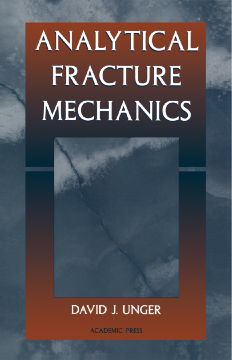
Additional Information
Book Details
Abstract
Fracture mechanics is an interdisciplinary subject that predicts the conditions under which materials fail due to crack growth. It spans several fields of interest including: mechanical, civil, and materials engineering, applied mathematics and physics. This book provides detailed coverage of the subject not commonly found in other texts.
Analytical Fracture Mechanics contains the first analytical continuation of both stress and displacement across a finite-dimensional, elastic-plastic boundary of a mode I crack problem. The book provides a transition model of crack tip plasticitythat has important implications regarding failure bounds for the mode III fracture assessment diagram. It also presents an analytical solution to a true moving boundary value problem for environmentally assisted crack growth and a decohesion model of hydrogen embrittlement that exhibits all three stages of steady-state crack propagation.
The text will be of great interest to professors, graduate students, and other researchers of theoretical and applied mechanics, and engineering mechanics and science.
- Presents the only analytical proven solution technique amenable to the second-order nonlinear partial differential equation governing a mode I elastoplastic crack problem
- Places emphasis on the near crack tip partial differential equations governing plasticity and process zone theory in environmental cracking phenomena
- Provides fundamental solutions of linear elastic fracture mechanics
- Explains how transport-controlled stage II environmental crack growth can be mapped onto the classic Stefan problem
- Predicts failure curves on fracture assessment diagram for mode III crack problem as transition occurs from plastic strip to finite-dimensional plastic zone
- Gives a summary of pertinent equations of linear elasticity and plasticity
"What is particularly valuable about this book, not found in most fracture books, is the consistent way in which groups of problems are treated (eg. all of the various SSY solutions, both new and old, are clearly presented and related to each other). Also, careful attention is paid to the various modes of fracture (I, II and II) and when information from a solution for one mode may or may not be used to infer information in another mode...the book is valuable to the new fracture mechanisms student, since it summarizes and puts in the same unified notation many of the previously-available analytical solutions. However, the books greater value may lie in the great variety of consistently-presented fundamental closed-form crack tip stress and displacement fields...Analytical Fracture Mechanics should prove to be a valuable resource to both the new student and the experienced researcher in fracture mechanics. It is recommended for purchase by all engineering libraries and as a supplement to a standard first of second fracture mechanics course." --D.A. Mendelsohn, Ohio State University, in APPLIED MECHANICS REVIEW
